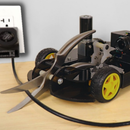Introduction: Marangoni Bursting
This Instructable will introduce the visually stunning effect called Marangoni bursting [1], explain the science behind it, and show how you can recreate this effect easily, and cheaply, at home or school.
As part of the Classroom Contest hosted by Instructables.com this tutorial will be presented in a format for teachers to readily adapt to a classroom environment, at a budget that is accessible to all schools and students. The Instructable builds up from basics and then iteratively applies what has been previously taught to each new situation. Teachers can follow the same steps in this Instructable by building up from an introduction of surface tension, to how surface tension creates Marangoni flows, to how the combination of surface tension and vapour pressure leads to a unique class of Marangoni flows called Marangoni bursting.
This Instructable is teachable at any level and would be great in a preschool environment purely for its visual enchantment, but for the deepest understanding of the science behind it students should be at least middle/high school age.
[1] L. Keiser, H. Bense, P. Colinet, J. Bico, and E. Reyssat. Marangoni Bursting: Evaporation-Induced Emulsification of Binary Mixtures on a Liquid Layer. PRL 118, 074504 (2017).
Supplies
General equipment
- Flat shallow dish/tray
- Paper towels (for cleaning)
For step 2
- Test tubes
- Water
- Mercury (not actually allowed at most schools but if you can find a video/picture of a Mercury in a test tube it is a good teaching point for a convex meniscus)
For step 3
- Milk
- Dish soap
- Food colouring
- Water
- Pepper (or other small floating particulate)
For step 5
- Isopropyl alcohol
- Water
- Cooking oil (I have verified this experiment works with vegetable and sunflower oil, but most cooking oils should work too)
- Food colouring
Step 1: 60 Minute Classroom Plan Advice
At the start of the lesson introduce the experiment with a 5 minute demonstration of Marangoni Bursting at the front of the classroom (instructions below in step 5) to capture the students attention. Then spend 35 minutes discussing the science behind the effect (as presented in steps 2, 3, 4, and 6), completing intermediate experiments along the way. After establishing an understanding of the theory, allow students to use the remaining time to recreate the Marangoni bursting experiment from the start of class as in step 5. Encourage independent investigation by instructing the students to adjust the ratio of mixed liquids and document their observations qualitatively. Different ratios will lead to: changes in the rate of reaction, droplet size, and the number of droplets. As homework have students write a formal lab report in which they explain their observations using the theoretical principles of surface tension and vapor pressure from the earlier class discussion.
Quick note on oil disposal:
Realistically in a classroom environment it is likely that one to two liters of cooking oil will be used in this experiment: potentially an expensive plumbing bill if poured down the drain. Check with your municipality for the most appropriate method to dispose of oils.
Step 2: Introducing Surface Tension
Surface tension is created by the cohesive forces of neighboring fluid particles at a surface. The strength of the cohesive forces between particles depends on the fluid.
A classical example of surface tension gradients is the meniscus formed at the boundary of a test tube and water. A concave meniscus is formed since the adhesive forces between the glass and water molecules at the boundary are greater than the cohesive forces between neighboring water molecules away from the boundary. Conversely, mercury in a test tube forms a convex meniscus as the cohesive forces between the liquid are stronger than the adhesive forces at the boundary of the test tube. These two different types of meniscus's demonstrate surface tension in everyday life.
Another great demonstration is placing a metal paperclip or needle on the surface of a cup of water. Despite being denser than water (this can be verified by agitating the surface of the water and watching the items sink), they still float on the surface! Discuss with the class why this is due to surface tension and where they have seen other instances of surface tension in the real world, some examples are: why morning dew comes in spherical beads, and how some species of insect can walk on water
As we will see in the next step, at the interface between 2 fluids with different surface tensions interesting effects can occur.
Step 3: Marangoni Flows
Applying the concepts from the previous section we will experimentally investigate Marangoni flows. Marangoni flow is a fluidic effect driven the gradient of surface tension between two fluids. Remind students that surface tension describes the intensity at which of one type of liquid pulls on its neighboring molecules. Hence if there is an interface of two liquids with different surface tensions, one liquid will pull more strongly on the other liquid. This imbalance of forces leads to Marangoni flow.
To demonstrate this visually, fill a shallow dish with water and grind pepper flakes on the surface. Using a toothpick deposit a small drop of dish soap in the center. The pepper flakes are instantly pulled outwards! This can be explained through a difference in surface tensions: water has a higher surface tension than dish soap. As such the water molecules exert a great force on its neighbors (in this case the pepper flakes). Before the dish soap is added the system is in static equilibrium: the water evenly pulls on each pepper flake in all directions. After adding dish soap there is an imbalance of forces (weaker forces pulling to the center and stronger forces pulling outwards), this imbalance drives the pepper flakes radially outwards. This is known as a Marangoni flow.
Students can achieve a similar result by filling a dish with milk and several drops of food colouring then depositing a small drop of dish soap. The physics describing this system are the same as the water and pepper flakes; to reinforce understanding have the students describe this experiment using surface tension.
Step 4: Vapour Pressure
Marangoni flows are fascinating in their own right, but before getting to the unique case of Marangoni bursting we must first introduce vapour pressure. Vapour pressure is the pressure a gaseous vapour exerts on its liquid counterpart when the system is in thermodynamic equilibrium. If two liquids (say, water and isopropyl alcohol) are left open at standard temperature and pressure their difference in vapour pressure can explain the difference in rates of evaporation.
Isopropyl alcohol (IPA) has a much higher vapour pressure than water. Therefore, IPA requires a high vapour pressure for an equilibrium between liquid and gas volumes to be maintained, in an attempt to move towards equilibrium the liquid IPA will evaporate at a faster rate than water. A further discussion can be had in class, however only the fundamentals of vapour pressure are required to explain the difference in evaporation rates in the context of this experiment.
Step 5: Marangoni Bursting (how To)
In step 6 we will discuss how what we have learned regarding vapour pressure and surface tension drives Marangoni bursting. But first let's actually do the experiment so we know what to expect.
Fill a flat, shallow dish with oil to a height of about 1cm. Separately mix water, isopropyl alcohol and food colouring, while I encourage independent experimentation a good starting point is a ratio of 3ml to 1.5ml to 2 drops of the 3 liquids, respectively. Use a syringe to deposit a small amount of this mixture on the bed of oil. The effect will begin instantly, sit back and enjoy the mesmerizing show.
Tips:
- Isopropyl alcohol evaporates rapidly, thus if you wait for several minutes between mixing and depositing the mixture on the oil, the concentration of alcohol will be different to when it was initially created the mixture.
- If you are doing repeated trials, I found that to save oil you can briefly lay a paper towel on the surface to absorb the water and ethanol droplets while keeping most of the oil in the bottom of the dish for the next trail. While I didn’t test it, this could also be a unique way of making tie dye shirts.
Step 6: Marangoni Bursting (an Explanation)
A question to ask students at this point is: what type of reaction is this? Many may say a chemical reaction because we are mixing different liquids. But this effect is entirely driven by the physical properties of each of the respective liquids.
As previous discussed, isopropyl alcohol has a higher vapour pressure than water, meaning it evaporates much faster and it also has a lower surface tension than water. Thus, at the edge of the drop the alcohol evaporates quickly resulting in a lower alcohol concentration at the edge relative to the centre. This lower concentration of alcohol means that the surface tension at the edge is stronger and so the interior mixture is pulled outwards via Marangoni flows. This cycle repeats with more and more of the mixture collecting at the outer rim.
As liquid collects at the outer rim, surface perturbations create instabilities and long fingers begin to protrude radially outwards. These fingers break into tiny droplets that shoot radially outwards. Together, the differences in surface tension and vapour pressure results in the stunning creation of hundreds of smaller droplets.
To encourage students to explore he scientific method I implore you to provide various different liquids to mix, oils and concentrations and have students record observations related to rate of reaction, droplet size and droplet count. Have them report their findings explained using surface tension and vapour pressure.
Step 7: Going Further
For any older students (of legal drinking age) consider how the principles learnt above can be translated to explain the “tears of wine” commonly observed in red wine. Hint: red wine is basically just water and ethanol.
I won’t explain this effect, but with some thought and experimentation you should be able to describe the process using the principles taught above. You can check your conclusions with these great explanation videos by Applied Science and Dan Quinn (picture credit to the latter).

Participated in the
Classroom Science Contest













